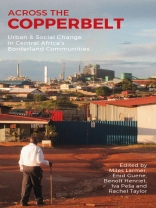The first comparative historical analysis – local, national and transnational – of the cross-border Central African copperbelt; a key work in studies of labour, urbanisation and African studies.
The Central African Copperbelt, encompassing the mining communities of Katanga (DR Congo) and Zambia, has been central to the study of modernisation and rapid social and political change in urban Africa. This volume expands upon earlier studies of industrial mining, male-dominated formal labour organisation and political change by examining both sides of the border from pre-colonial history to the present and encompassing a wide range of economic, social and cultural identities and activities. Bringing together scholars from a range of disciplines, the contributors explore copperbelt communities’ sense of identity – expressed in comic strips and football matches, their precarious and inventive ways of living, their involvement in church and education, and the processes and impact of urbanisation and development, environmental degradation and changing gender relations. A major contribution to borderland studies, in showing how the meaning and relevance of the border to the copperbelt’s mixed and mobile population has changed constantly over time, the book’s engagement with communities at the nexus of social, economic and political change makes it a key study for those working in global urban development.
This book is available under the Creative Commons license CC-BY-NC. It is based on research that is part of a project that has received funding from the European Research Council (ERC) under the European Union’s Horizon 2020 research and innovation program (grant agreement no: 681657): ‘Comparing the Copperbelt: Political Culture and Knowledge Production in Central Africa’.
Tabela de Conteúdo
Introduction – Enid Guene and Benoît Henriet and Miles Larmer and Iva Pesa and Rachel Taylor
PART 1: MICRO-STUDIES OF URBAN LIFE
Beyond Paternalism: Pluralising Copperbelt Histories – Iva Pesa and Benoît Henriet
Being a Child of the Mines: Youth Magazines and Comics in the Copperbelt – Enid Guene
Divergence and Convergence on the Copperbelt: White Mineworkers in Comparative Perspective, 1911 – 63 – Duncan Money
Football on the Zambian and Katangese Copperbelts: Leisure and Fan Culture from the 1930s to the Present – Hikabwa D. Chipande
Beware the Mineral Narrative: The Histories of Solwezi Town and Kansanshi Mine, Northwestern Zambia – Rita Kesselring
PART 2: THE LOCAL COPPERBELT AND THE GLOBAL ECONOMY
Kingdoms and Associations: Copper’s Changing Political Economy during the Nineteenth Century – David M. Gordon
Of Corporate Welfare Buildings and Private Initiative: Post-Paternalist Ruination and Renovation in a Former Zambian Mine Township – Christian Straube
From a Colonial to a Mineral Flow Regime: The Mineral Trade and the Inertia of Global Infrastructures in the Copperbelt – Hélène Blaszkiewicz
Houses Built on Copper: The Environmental Impact of Current Mining Activities on ‘Old’ and ‘New’ Zambian Copperbelt Communities – Jennifer Chibamba Chansa
PART 3: PRODUCING AND CONTESTING KNOWLEDGE OF URBAN SOCIETIES
‘The British, The French and even the Russians use these Methods’: Psychology, Mental Testing and (Trans)Imperial Dynamics of Expertise Production in Late Colonial Congo – Amandine Lauro
Historical Knowledge Production at the University of Lubumbashi (1956 – 2018) – Donatien Dibwe dia Mwembu
The Decolonisation of Community Development in Haut Katanga and the Zambian Copperbelt, 1945 – 1990 – Miles Larmer and Rachel Taylor
Reimagining the Copperbelt as a Religious Space – Stephanie Lämmert
Sobre o autor
MILES LARMER is Professor of African History, University of Oxford.












